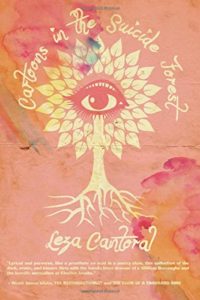Review: ‘Cartoons in the Suicide Forest’ by Leza Cantoral
By Jordan Blum
Posted on
I hate the pain. I hate the mindlessness torture of loving someone. I hate the meaningless of it all.
– Leza Cantoral, Cartoons in the Suicide Forest

“Spawned” in 2013 as an imprint of JournalStone Publishing, Bizarro Pulp Press has quickly become a major name in the realm of speculative prose, as it specializes in offering “dark pulp fiction for readers who enjoy art that challenges the boundaries of ‘normal’ in the literary world.” With over two dozen wonderfully weird works under its belt, it’s fair to say that B.P.P. champions the bold, unusual, and fearless, which is why its newest release, Leza Cantoral’s Cartoons in the Suicide Forest, feels perfectly at home next to its twisted siblings. As an editor at both CLASH Media and Luna Luna Magazine, Cantoral is no stranger to hard-hitting explorations of topics like sexuality, femininity, abuse (be they physical, emotional, and/or mental), subjugation, and identity, all of which she touches upon here with poised eccentricity, imagination, and valor. While its frequent depravity can be a bit repetitive and superficially shocking at times, almost all of Cartoons in the Suicide Forest is fresh, ingenious, eloquent, and powerful.
The titular story opens the set, and it’s easily one of her top triumphs. (In fact, it’s one of the best pieces of fiction I’ve read in a long time.) Broken into multiple sections (as are several other entries), it’s a beautiful yet nightmarish fairy tale that’s captivating and creative from beginning to end. Whereas many authors use poetic abstraction and oddities to distract from a lack of palpable substance, Cantoral enhances her poignant tale of hopelessness, abortion, fragility, and erroneous love with delightfully unusual details and narrative progression. In other words, there’s a lot of relatable emotion and circumstance behind the perverse and ethereal rawness (which seems inspired by notable horror ventures like The Exorcist, The Shining, Antichrist, The Evil Dead, and Cronenberg’s The Fly). Take the following excerpt—which involves a “crowd of pale gray girls. . . . danc[ing] a strange calliope song” around the protagonist—as an example of how tragic, delicate, and surreal “Cartoons in the Suicide Forest” is:
I cannot stop crying. The pain of everything that has hurt me hits me like a tidal wave. The sad drowns out everything else inside of me and the tears come flooding out. My tears start turning colors as they stream through my shaking hands. Red rage floods out, and the yellow madness that has been eating my brain burns my eyes like crushed lemons.
By the time I am crying out the greens, they are telling me that I am already dead and I believe them, and when the blue tears come, I am ready.
Nearly every subsequent selection packs a similar mixture of uninhibited peculiarities, adult themes, and moving subtexts. Whether it’s the cautionary overtones and fascinating POV shifts of “Siberian Honeymoon,” the sinister surprises of “Green Lotus,” the brave recollections of “Last Dance with Heroin,” the vibrant interstellar transcendences of “Dope” and “Cosmic Bruja,” or the wicked reimaginings of “Beast” and “Planet Mermaid,” Cantoral ensures that her stories are as wildly entertaining as they are affective and earnest. There’s a Lynchian quality to them, too, in that there’s usually a disturbing underbelly beneath an outwardly normal surface, as well as an almost shared universe that revolves around the influence of colors, dreams, animalistic instincts, and oppression/obedience. In that sense, these twelve tales are simultaneously unconnected and cumulative, standing on their own while also playing their part to yield a singular statement.
As with anything that’s often relentlessly debauched and bleak, though, Cartoons in the Suicide Forest overdoes its graphic content now and then, especially during its second half. Of course, literature, like all forms of art, should never be censored (after all, some subjects require brutally specific depictions to resonate completely), but Cantoral regularly envisions scenes of sexual violence that would make Palahniuk and Ellis blush, and you can only read lines like “Gut that cow. Fuck it. Slice it. Her flesh is smooth. . . . She has no power over you. You ejaculate on her face, blinding her little piggy eyes” (from “Suicide Pigs”) so many times before it becomes routine and ineffective. In particular, “Fist Pump” seems appalling just for the sake of it, as its narrator exchanges valuable drugs for the “pleasure” of being raped and beaten by several gang members. Sure, sparking a visceral reaction can be its own justification, but without a discernable moral or commentary behind the revulsion, it feels more akin to a Hostel or Guinea Pig film than it does to, say, Irreversible, American Psycho, or Requiem for a Dream.
Even with that sporadic detriment, Cartoons in the Suicide Forest is an exceptional collection that cements Leza Cantoral as a masterful storyteller whose command of pacing and expression is matched by her daring honesty and boundless attention to detail and innovation. She challenges conventions of form and taste at every turn yet rarely seems to do it without a deeper purpose, which is why most these stories are poetic, heartfelt, strange, and repulsive at once. Above all else, Cantoral demonstrates that fiction doesn’t have to sacrifice tangible and universal meaning for avant-garde visualizations; rather, they can coexist to produce stories that are unforgettable in multiple ways.
*Cartoons in the Suicide Forest is also available through Amazon. Be sure to check out our recent interview with her, too.